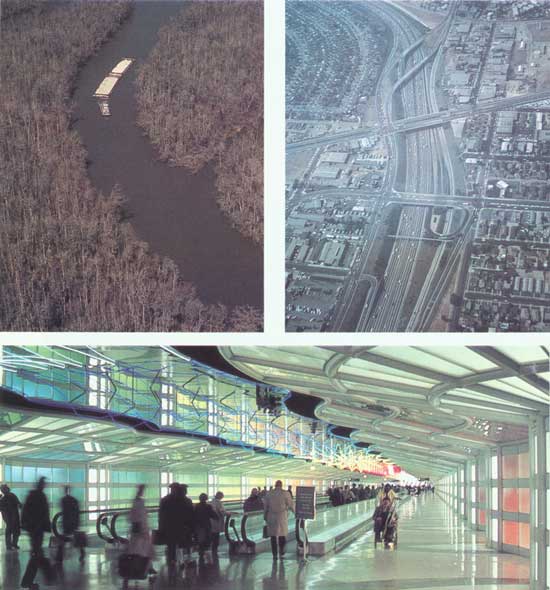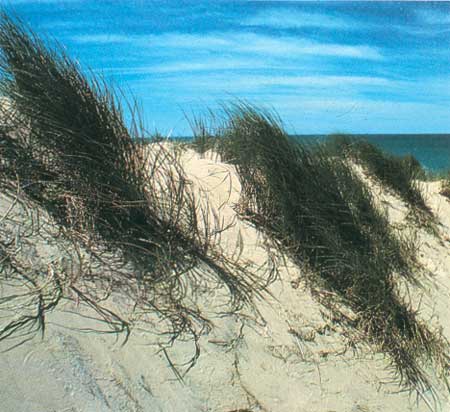
|
Geological Survey Circular 1085
Our Changing Landscape: Indiana Dunes National Lakeshore |

(Gary North)
LAND USE
The European colonists, who arrived in North America in the early 1600's, used resources from the land and sea just as the Native Americans had been doing for centuries. As the colonies expanded, the need for new land and mineral resources grew also. In less than 300 years, the colonies were transformed into an industrial power. Demands for natural resources became sophisticated; land-use needs became ever more complex.
As our population continues to grow and our material needs become more complicated and urgent, an area will prosper only if it can accommodate these increased needs for a long time and if it has a secure and adequate natural resource base. For instance, transportation facilities, such as pipelines, powerlines, tunnels, bridges, waterways, roads, railroads, and airports, serve to move us and the many products that are vital to our cities' welfare. Knowledge of the geology of the land is essential to ensuring efficient, reliable, and safe transportation systems.

|
| Top left: The Pearl River in Louisiana serves as a transportation corridor for shipping of bulk materials. (Gary North) Top right: Major transportation facilities, such as this highway system in Los Angeles, are vital to our cities' welfare. (Gary North) Bottom: Airports need to be expanded as the demand on them increases. This "people mover," in Chicago's O'Hare Airport, helps speed travelers on their way. (Gary North) |

|
| These aerial photographs show results of decisions made by land-use managers over time. (Gary North) |

|
| Coastal areas have long attracted large urban populations, as evidenced by cities such as Chicago. (Gary North) |

|
| The semiarid Los Angeles Basin, in California, as seen on this color-infrared photograph, is an example of a highly urbanized area that continues to be challenged by complex land-use and land-management decisions. Accessing and distributing water to an ever-growing population is also a difficult challenge. (Gary North) |
Hundreds of daily activities require energy and mineral resources. It is estimated that each American requires 40,000 pounds of new minerals every year to maintain his or her current standard of living. Proper management of our Nation's resources and a balanced approach to land use allow us to use the land while sustaining the economy. Earth-science information identifies the location of natural resources—information critical to land management. The land manager has to recognize a variety of user needs and develop a management plan to accommodate those needs while still sustaining and maintaining the land and its resources. Parks such as Indiana Dunes National Lakeshore provide a unique setting in which to learn how lands and resources might be managed and preserved in harmony with surrounding communities and industrial sites that make intensive use of the land.

|
| This color-infrared aerial photograph shows a major part of Indiana Dunes National Lakeshore. Vegetation is shown in red. (EROS Data Center) |

|
| A park ranger explains how proper management of natural resources may allow nature and industry to coexist. (Bob Daum) |

|
| Map of Indiana Dunes National Lakeshore (click on image for a PDF version) |
The region south of Lake Michigan has grown from an area of small fishing villages and farming communities to a major industrial center and transportation avenue for the United States. This growth was originally spurred by the presence of Lake Michigan, the sixth largest lake in the world, which provided a dependable source of water suitable for most uses. Today, this region is a major transportation corridor, with shipping ports, vast railroad systems, international airports, and interstate highways.
At one time, Highway 12, which runs through Indiana Dunes, was the major highway between the Eastern and Western United States. Now, Highway 12 has been superseded by several interstate highways and the St. Lawrence Seaway, transportation facilities that are critical to the area's industry. Steel mills with 20 percent of the Nation's steel-making capacity are adjacent to Indiana Dunes, as are electric generating stations that burn fossil fuels.

|
| Lake Michigan is a major recreational resource. (Gary North) |

|
| Fragmentation of the park land by urban areas can create islands of natural ecosystems and can disrupt the natural movement of plants and animals. (Indiana Dunes National Lakeshore) |
As the area has developed commercially and residentially, Indiana Dunes has become an increasingly popular recreation spot. Annual visitation to the Indiana Dunes National Lakeshore has risen from several thousand in 1966, the year in which it was established by Congress, to nearly 2 million in 1990. These numbers are not surprising, because approximately 8.5 million people live within a 90-minute drive of the park.
The growth of Indiana Dunes National Lakeshore has occurred in stages that have resulted from four separate laws enacted by Congress. These laws, passed in 1966, 1976, 1980, and 1986, gave the National Park Service the authority to purchase land and establish the park. Because parcels of land have been added to Indiana Dunes since the original 1966 purchase, the boundaries of the whole park have become irregular, with several areas fragmented or isolated from other park areas. Currently, Indiana Dunes is divided into nine land units, many of them "islands" surrounded by industry, transportation facilities, agricultural areas, or municipalities. This fragmentation creates barriers that disrupt the ecosystem by impairing the natural movement of plants and animals.
Indiana Dunes is most unusual in that its 14,000 acres are home to 1,445 species of plants.

|
| Dune plants help stabilize and prevent sand from being blown away by the wind. |

|
| Dr. Henry Cowles, whose 20 years of research led to Indiana Dunes being known as the birthplace of ecology said in 1916, "Botanically the Indiana Dunes are a . . . floral melting pot . . . [where] one may find plants of the desert . . . rich woodlands . . . pine woods . . . swamps . . . oak woods . . . and prairies together in such abundance as to make the region a natural botanical preserve . . ." (Bob Daum) |
Indiana Dunes is most unusual in that its 14,000 acres are home to 1,445 species of plants. Only two national parks have more plant species: Great Smoky Mountains (1,485) and Grand Canyon (1,474). Each of these two parks has more than a half million acres of land—35 times as much land as at Indiana Dunes.
|
Ecosystem Fragmentation Most ecosystems are recognized as being open systems, subject to energy inputs and outputs and immigration and emigration of species. Natural communities are protected within the park boundaries, but the park has little control outside its boundaries. Thus, the natural ecosystem processes are subject to disruption, and the park functions as an "island." Indiana Dunes is a classic example of an "island park," because it is surrounded by industry, major transportation corridors, agriculture, and municipalities. In addition, within the park, roads have been built, ditches cut, and other barriers created, all of which disrupt natural processes. The result is ecosystem fragmentation. Although not well understood, ecosystem fragmentation has the potential to disrupt the flow of energy or the natural movement of species and species diversity. For example, studies have shown forest patch size to affect the local variety of bird species. Other studies have shown that roads and agriculture can act as barriers to gene flow among small mammal, reptile, and amphibian populations. In addition, the size of the "island ecosystems" limits their use only to those plant and animal species that can survive and reproduce within the limited area. If the plant or animal species cannot survive in the "island" fragment, it will disappear from the area.
|

|
| Top: Indiana Dunes National Lakeshore; Middle left: Gary North; Middle right: Indiana Dunes National Lakeshore; Bottom left and right: Indiana Dunes National Lakeshore |
| <<< Previous | <<< Contents >>> | Next >>> |
circ/1085/sec3.htm
Last Updated: 27-Apr-2009
